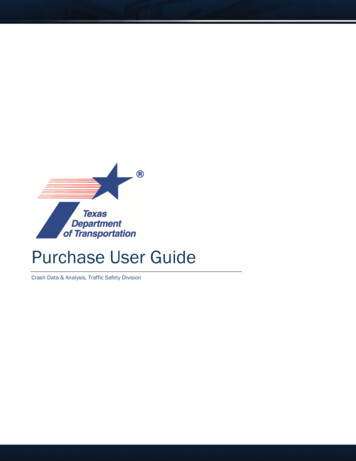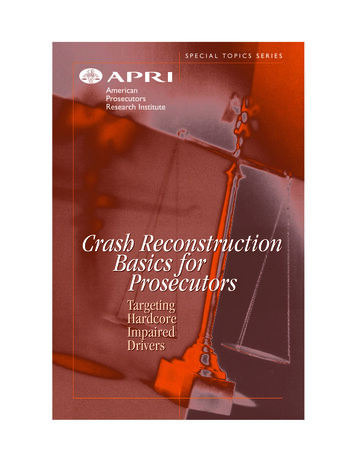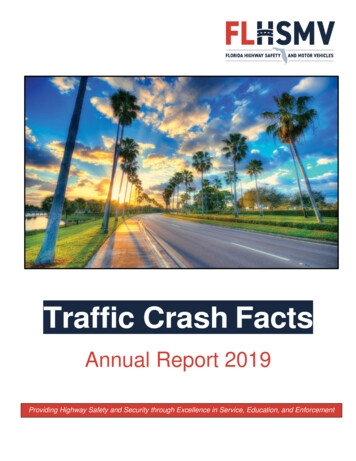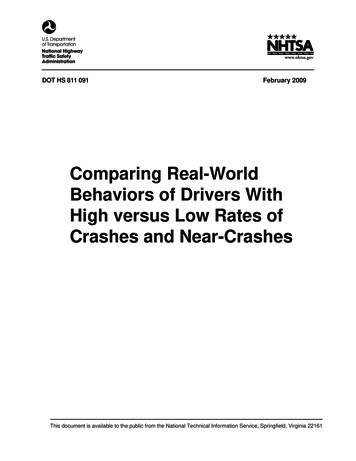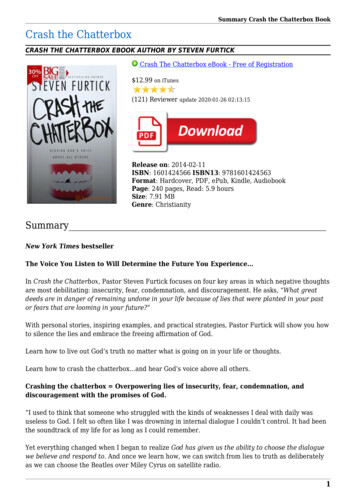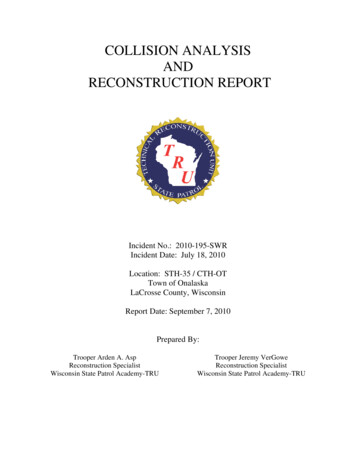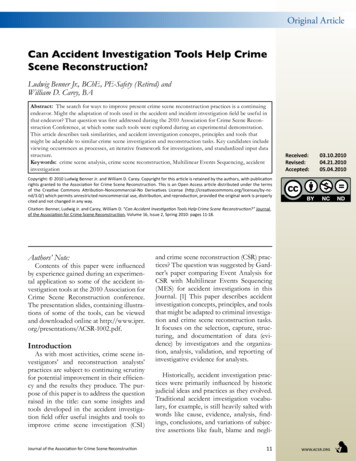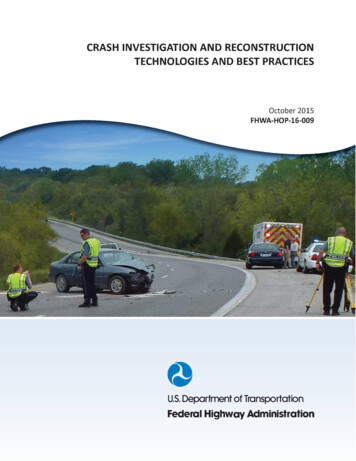
Transcription
NOTICEThis document is disseminated under the sponsorship of the U.S. Department of Transportation(USDOT) in the interest of information exchange. The U.S. Government assumes no liability forthe use of the information contained in this document. This report does not constitute a standard,specification, or regulation. The U.S. Government does not endorse products or manufacturers.Trademarks or manufacturers’ names appear in this report only because they are consideredessential to the objective of the document.QUALITY ASSURANCE STATEMENTThe Federal Highway Administration (FHWA) provides high-quality information to serveGovernment, industry, and the public in a manner that promotes public understanding. Standardsand policies are used to ensure and maximize the quality, objectivity, utility, and integrity of itsinformation. FHWA periodically reviews quality issues and adjusts its programs and processesto ensure continuous quality improvement.Source, Cover: photo courtesy of KC Scout and the Kansas City Police Department
TECHNICAL REPORT DOCUMENTATION PAGE1.Report No.2.Government Accession No.3.Recipient’s Catalog No.5.Report DateFHWA-HOP-16-0094.7.Title and SubtitleCrash Investigation and Reconstruction Technologies and BestPracticesOctober 20156.Performing OrganizationCodeAuthor(s)8.Performing OrganizationReport No.William James, Steve McKinzie, William Benson, Cliff Heise9.Performing Organization Name and Address10. Work Unit No. (TRAIS)Iteris, Inc.107 Carpenter Drive, Suite 230Sterling, VA 20164Subconsultants: Gannett Fleming11. Contract or Grant No.Contract No.DTFH61-12-D-00037Task Order No. 500912. Sponsoring Agency Name and Address13. Type of Report and PeriodCoveredFederal Highway AdministrationOffice of Operations1200 New Jersey Avenue SEWashington, DC 20590Informational Guide BookAugust 2014 - September201514. Sponsoring Agency CodeFHWA HOP15. Supplementary NotesPaul Jodoin, FHWA GTM16. AbstractTraffic crashes have an effect on the lives of those involved, the lives of those who respond to theincident and the lives of those who investigate the incident. The collection of evidence at a crashscene is very important but the exposure of responders to the dangers of traffic increases the chanceof a secondary collision occurring. When technology is effectively applied to traffic incidentmanagement and crash investigation, safety is increased and traffic congestion is minimized. Theuse of traffic crash reconstruction technology has a significant impact on the safety of theinvestigators, the traveling public and the operation of the transportation system. This reportexamines available crash investigation and reconstruction technology. The evolution of trafficcrash reconstruction technology has introduced many new types of equipment to this field, as wellas constantly evolving innovations. The report provides information about each technology’scapabilities and limitations to inform crash investigation units of the options available.17. Key Words18. Distribution StatementCrash, reconstruction, investigation, incident,accident, traffic incident management, safety19. Security Classif. (or thisreport)20. Security Classif. (of this21. No. of Pages22. Pricepage)UnclassifiedForm DOT F1700.7 (8-72)No restrictions.Unclassified80Reproduction of completed pages authorizedCrash Investigation and ReconstructionTechnologies and Best PracticesiU.S. Department of TransportationFederal Highway Administration
METRIC CONVERSION CHARTSYMBOLAPPROXIMATE CONVERSIONS TO SI UNITSWHEN YOU KNOWMULTIPLY BYTO i2square inchessquare feetsquare yardacressquare rskilometersmmmmkmsquare millimeterssquare meterssquare metershectaressquare TEMPERATURE (exact degrees)oFFahrenheit5 (F-32)/9or E CONVERSIONS FROM SI UNITSSYMBOLWHEN YOU hakm2square millimeterssquare meterssquare metershectaressquare kilometersMULTIPLY BYTO FINDSYMBOLinchesfeetyardsmilesinftydmisquare inchessquare feetsquare yardsacressquare 01610.7641.1952.470.386TEMPERATURE (exact degrees)oCCelsius1.8C h Investigation and ReconstructionTechnologies and Best flU.S. Department of TransportationFederal Highway Administration
TABLE OF CONTENTSEXECUTIVE SUMMARY . 1CHAPTER 1 INTRODUCTION . 5PROGRESSION OF LAW ENFORCEMENT INVESTIGATION TECHNOLOGY . 6TRAFFIC CRASH RECONSTRUCTION 101 . 8RELATIONSHIP BETWEEN CRASH RECONSTRUCTION AND TRAFFIC INCIDENTMANAGEMENT . 9CHAPTER 2 INPUT FROM EXPERIENCED CRASH RECONSTRUCTIONPROFESSIONALS . 11RESEARCH OF PRACTICES AND TECHNOLOGIES . 13FUNDING DECISIONS . 14BEST PRACTICES . 14CHAPTER 3 RESEARCH METHODOLOGY . 15SURVEY OVERVIEW . 15CHAPTER 4 RESEARCH RESULTS . 17CHAPTER 5 TECHNOLOGY OVERVIEW . 19MECHANICAL MEASUREMENT TOOLS . 19ELECTRONIC TOTAL STATION . 21REFLECTORLESS ELECTRONIC TOTAL STATION . 23SEMI-ROBOTIC TOTAL STATION . 26ROBOTIC TOTAL STATION . 29TOTAL STATION HYBRID . 32CLOSE-RANGE PHOTOGRAMMETRY . 35THREE-DIMENSIONAL LASER SCANNING . 38UNMANNED AERIAL SYSTEMS. 41GLOBAL POSITIONING SYSTEMS . 44LIGHT DETECTION AND RANGING SYSTEMS . 46IMAGING STATIONS . 48CHAPTER 6 VIRTUAL DEMONSTRATIONS . 51CHAPTER 7 CONCLUSIONS . 53APPENDIX A: EXPERT PANEL BIOGRAPHIES. 55APPENDIX B: TECHNOLOGY RANKINGS . 63RANKING IN ORDER . 63COURT ACCEPTANCE . 69Crash Investigation and ReconstructionTechnologies and Best PracticesiiiU.S. Department of TransportationFederal Highway Administration
COST . 70BIBLIOGRAPHY . 71LIST OF FIGURESFigure 1. Graph. Traffic Incident Management Event Sequence . 5Figure 2. Graph. Expert Panel Members' Geographic Distribution . 11Figure 3. Photo. Mechanical Measurement Tool . 20Figure 4. Photo. Electronic Total Station. 22Figure 5. Photo. Reflectorless Total Station . 25Figure 6. Photo. Semi-Robotic Total Station . 28Figure 7. Photo. Robotic Total Station . 31Figure 8. Photo. Total Station Hybrid. 34Figure 9. Photo. Photogrammetry . 37Figure 10. Photo. Three-dimensional Laser Scanning . 40Figure 11. Photo. Unmanned Aerial Systems . 43Figure 12. Photo. Global Positioning Systems . 45Figure 13. Photo. Light Detection and Ranging Systems . 47Figure 14. Photo. Imaging Stations. 50Crash Investigation and ReconstructionTechnologies and Best PracticesivU.S. Department of TransportationFederal Highway Administration
LIST OF TABLESTable 1. Technology Rating Criteria . 2Table 2. Research Summary . 3Table 3. Crash Reconstruction Technology and Best Practice Panelists . 12Table 4. Technology Rating Criteria . 17Table 5. Mechanical Measurement Tools Equipment and Costs . 19Table 6. How the Experts Rated Mechanical Measurement Tools . 20Table 8. Electronic Total Station Equipment and Costs . 21Table 9. How the Experts Rated Electronic Total Station . 22Table 11. Reflectorless Electronic Total Station Equipment and Costs . 23Table 12. How the Experts Rated Reflectorless Total Station. 25Table 14. Semi-Robotic Equipment and Costs . 26Table 15. How the Experts Rated Semi-Robotic Total Station . 28Table 17. Robotic Total Station Equipment and Costs . 29Table 18. How the Experts Rated Robotic Total Station . 31Table 20. Total Station Hybrid Equipment and Costs . 32Table 21. How the Experts Rated Total Station Hybrid . 34Table 23. Photogrammetry Equipment and Costs . 35Table 24. How the Experts Rated Photogrammetry . 37Table 26. Three-dimensional Laser Scanning Equipment and Costs . 38Table 27. How the Experts Rated Three-dimensional Laser Scanning . 40Table 29. Unmanned Aerial Systems Equipment and Costs . 42Table 30. How the Experts Rated Unmanned Aerial Systems . 43Table 32. Global Positioning System Equipment and Costs . 44Table 33. How the Experts Rated GPS Systems. 45Table 35. Light Detection and Ranging Systems Equipment and Costs . 46Table 36. How the Experts Rated Light Detection and Ranging Systems . 47Table 38. Imaging Stations Equipment and Costs . 48Table 39. How the Experts Rated Imaging Stations . 50Crash Investigation and ReconstructionTechnologies and Best PracticesvU.S. Department of TransportationFederal Highway Administration
LIST OF ABBREVIATIONS AND SYMBOLS2-D – Two-dimensional3-D – Three-dimensionalA&M – Agricultural and MechanicalACTAR - Accreditation Commission for Traffic Accident ReconstructionAGL – Above Ground LevelAGPS – Assisted Global Positioning SystemCAD – Computer Aided DiagrammingCAR – Collision Analysis ReconstructionCOA – Certificates of AuthorizationDGPS – Differential Global Positioning SystemDOD – Department of DefenseDOT – Department of TransportationDUI – Driving Under the InfluenceEDM – Electronic Distance Measurement InstrumentFAA – Federal Aviation AdministrationFHWA – Federal Highway AdministrationGCP – Ground Control PointGLONASS - Global Navigation Satellite SystemGNSS – Global Navigation Satellite SystemGPS – Global Positioning SystemHD – High-DefinitionIACP – International Association of Chiefs of PoliceIPTM - Institute of Police Technology and ManagementITS – Intelligent Transportation SystemsLiDAR – Light Detection and RangingN/A – Not ApplicableNAS – National Air SpaceNTSB – National Transportation Safety BoardNUG – National Unified GoalOEM – Original Equipment ManufacturerRMT – Remote Measuring TargetRTK – Real Time KinematicSAE – Society of Automotive EngineersSLR – Single-Lens ReflexTCRU - Traffic Crash Reconstruction UnitTIM – Traffic Incident ManagementUAS – Unmanned Aerial SystemWAAS – Wide Area Augmentation SystemCrash Investigation and ReconstructionTechnologies and Best PracticesviU.S. Department of TransportationFederal Highway Administration
EXECUTIVE SUMMARYCrash investigators have been reconstructing the circumstances surrounding traffic crashes sincethe first crash involving the automobile occurred. Investigations are carried out by lawenforcement investigators and private crash professionals. While the majority of traffic crashesinvolve human error on the part of those involved in the crash, many crashes occur due toengineering issues. Without fully investigating and reconstructing a crash, the true cause orcauses of the crash may not be determined.While the collection of evidence at a crash scene is very important, the crash investigators andresponders are at risk when they are exposed to vehicular traffic at the incident scene. Asreported by the Federal Highway Administration’s Traffic Incident Management Program, forevery minute that the primary incident continues to be a hazard, the chance of being involved ina secondary collision increases by 2.8%. Traffic incident management is a vital part of the crashinvestigation process. By utilizing technology effectively for the management of trafficincidents and crash investigation, safety is improved and congestion is minimized.While the safety of responders and motorists is the highest priority in Traffic IncidentManagement and crash investigation, the economic impact of congestion must also beconsidered. According to the 2015 Urban Mobility Scorecard 1 published by the Texas A&MTransportation Institute, travel delays due to traffic congestion caused drivers to waste more thanthree billion gallons of fuel and kept travelers stuck in their cars for nearly seven billion extrahours – 42 hours per rush-hour commuter. The result is a total nationwide price tag of 160billion, or 960 per commuter. In addition, 18 percent or 28 billion of the delay cost was theeffect of congestion on truck operations; the cost does not include any value for the goods beingtransported in the trucks.The 2015 Urban Mobility Scorecard report predicts urban roadway congestion will continue toworsen without more assertive approaches on the project, program, and policy fronts. By 2020,with a continued good economy: Annual delay per commuter will grow from 42 hours to 47 hours, Total delay nationwide will grow from 6.9 billion hours to 8.3 billion hours, Total cost of congestion will jump from 160 billion to 192 billion.The economic impact of congestion cannot be ignored. The utilization of traffic crashreconstruction technology has a significant impact on congestion and the cost to motorists.The technology available for the investigation and reconstruction of traffic crashes has evolvedover time. The basic investigative tools are a measuring tape, a rolling measuring device or acombination of these tools. The evolution of traffic crash reconstruction technology hasintroduced many new types of equipment to this field, as well as evolving practices and methods.12015 Urban Mobility Scorecard, Texas A&M Transportation Institute (August 2015)Crash Investigation and ReconstructionTechnologies and Best Practices1U.S. Department of TransportationFederal Highway Administration
Crash investigation equipment available today is capable of accurately capturing the evidence ata crash scene for the purpose of reconstructing crashes.The evaluation of technology can be very subjective. To minimize the subjectivity, a panel ofexperts in the field of traffic crash reconstruction was established. The panel, consisting ofrepresentatives of law enforcement, private traffic crash reconstruction professionals, statedepartments of transportation, and the National Transportation Safety Board (NTSB), wasconsulted to guide the research of the technology. Each technology was rated on ResponderSafety, Quick Clearance and Court Acceptance using the criteria presented in Table 1. Table 2summarizes the results of this research.Table 1. Technology Rating CriteriaRating CriteriaResponder SafetySafe, Quick ClearanceCourt AcceptanceVery UnsafeUnsafeSafeExtended ClearanceModerate Clearance TimeQuick ClearanceNot AcceptedSome AcceptanceAcceptedCrash Investigation and ReconstructionTechnologies and Best Practices2U.S. Department of TransportationFederal Highway Administration
Table 2. Research rement Tools1211Photogrammetry77210831124235996347Robotic Total Station458Imaging Station611108101111212569Light Detection andRanging (LiDAR)Electronic TotalStationReflectorless TotalStationGlobal PositioningSystem (GPS)Semi-Robotic TotalStationThree-dimensional (3D) Laser ScanningUnmanned AerialDevicesHybrid Total StationCrash Investigation and ReconstructionTechnologies and Best Practices3U.S. Department of TransportationFederal Highway Administration
CHAPTER 1 INTRODUCTIONThe Federal Highway Administration’s (FHWA) investigation of practices and technologies thataffect crash reconstruction supports improved safety of incident responders and the travelingpublic. The successful investigation of these methods guides successful Traffic IncidentManagement (TIM), as identified in the National Unified Goal for TIM (NUG) which can befound at ost roadway-related Intelligent Transportation Systems (ITS) mainly address improveddetection and notification activities as illustrated in Figure 1 which is courtesy of FHWA’sStrategic Highway Research Program (SHRP2) National TIM Responder Training Program.Roadside detectors and cameras support the identification of traffic disruptions. Cameras add adeeper level of validation and understanding, while message signs alert, inform, or guidedecisions for drivers and those contemplating travel on a roadway. The technology used in crashreconstruction, in concert with ITS equipment, supports the timely removal of traffic crashobstructions in the response and clearance phases, and maintains the integrity of the crashinvestigation data collected at the scene.Figure 1. Graph. Traffic Incident Management Event SequenceCrash Investigation and ReconstructionTechnologies and Best Practices5U.S. Department of TransportationFederal Highway Administration
Technologies from other disciplines have been or are being studied and evaluated to supportcrash investigation and TIM activities. Among these are: Fire apparatus that are equipped with advanced lighting and incident scene clearancetools, Ambulances that are equipped with the most recent patient care innovations, Towing and recovery vehicles that have computerized systems, Law enforcement professionals that have highly specialized onboard and mobileequipment for completing their tasks and contributing to other aspects of TIM.As agencies move toward reliable reporting of TIM-related performance measures, thesetechnologies and the practices that employ them will be vital parts of the maturation of TIMprograms.PROGRESSION OF LAW ENFORCEMENT INVESTIGATIONTECHNOLOGYThere are currently many types of technology used for traffic crash investigation andreconstruction. The basic method involves the use of measuring tapes, rolling measuringdevices, levels and formula calculations to determine the course of events and the cause of acrash. This method is currently in use in the majority of law enforcement agencies throughoutthe United States.Technological improvements have generally addressed accuracy, speed, or a combination ofboth. However, in some jurisdictions the laws and policies that govern crash investigation havenot kept pace. When transportation professionals engage law enforcement and other publicsafety professionals, they must recognize that quick clearance starts with responder safety.Attention to responder safety priorities can be a sensitive issue in many locations where lawenforcement professionals feel as though they are being pushed to open roads more quickly andwithout regard for the important task of collecting crash investigation evidence.There have been considerable changes in the technology that is available for traffic crashreconstruction. Many methods use a platform commonly used in surveying to create a forensicmap of a crash scene. Other methods use lasers or Global Positioning System (GPS) devices. Inaddition to the forensic maps of the crash scene, many technologies allow for the creation ofcrash simulations and three-dimensional (3-D) models. These technologies also capture dataused to determine the course of events and the cause of a crash.Much of the technology in use today is widely available and becoming more affordable, whileemerging technology is expensive and not widely available. There is currently no referenceguide for law enforcement administrators or other traffic crash reconstruction professionals touse when planning equipment purchases. The available information is based on the experienceof individual agencies or manufacturers.The technologies and best practices identified in this report will assist agencies in determiningwhich technologies will best meet their crash investigation and TIM needs. There is no “one sizeCrash Investigation and ReconstructionTechnologies and Best Practices6U.S. Department of TransportationFederal Highway Administration
fits all” approach for traffic crash reconstruction. The basic, mechanical measuring process andequipment may fit the needs of some, but others may need more advanced, specializedcapabilities to achieve their goals. The research conducted for this report examined thetechnology in use today, how it can be used to achieve the goals of the NUG, the cost of thetechnology, and its availability for use in traffic crash reconstruction.The underlying needs for this research are to provide a safer environment for responders, a saferenvironment for motorists, and to minimize the effect that traffic crashes have on traffic flow.The manner in which the technology is applied is just as important as the technology itself. Themost advanced technology available is no more valuable if it is not used in an efficient manner tominimize the exposure of personnel to the dangers of traffic in the roadway.Law enforcement professionals must weigh the need to obtain and record information related tocrashes versus the danger to investigators, responders and other highway users. Most crashesthat occur are minor, they are cleared quickly, and do not require in-depth investigation andreconstruction. However, in-depth investigation of moderate and major crashes is necessary dueto the circumstances, severity, or other factors. These crashes take longer to investigate andoften result in roadway closures. Closing lanes on a highway increases the risk of a second crashoccurring. In many cases, secondary crashes are more severe than an initial crash. Reducing thenumber of secondary crashes on the nation’s highways is a primary goal of the Federal HighwayAdministration and is an important part of the Towards Zero Initiative.A crash reconstructionist has a job that is unique, and any reconstructionist could be faced with ascenario such as the following:1. An incident occurs that requires and gets emergency response.2. The need for crash reconstruction and investigation is identified and a call is made for atrained specialist, who now asks: Do I have the technology tools I need and are they in working order? Are there special circumstances I need to worry about? How has traffic been affected? How is traffic affecting the scene? Will I encounter delays in ingress to the scene? Will the scene be intact or altered by the time I get there? Has evidence been preserved? What do I need to tell those on-scene to do until I get there? Will I need to go anywhere else other than the crash scene? Will I need to talk with specific persons not available now? How will I communicate with responders on-scene until I arrive? When I arrive, what can I do to minimize the effects on traffic while still protectingresponders and motorists?Crash Investigation and ReconstructionTechnologies and Best Practices7U.S. Department of TransportationFederal Highway Administration
Is the technology that I have the best for this investigation or do I need to call forassistance? Can the evidence at the crash scene be marked and the mapping completed at a safer,more convenient time?TRAFFIC CRASH RECONSTRUCTION 101There is no one type of technology that addresses all the needs for traffic crash reconstruction.Each crash or incident involves unique circumstances. In many jurisdictions the cost of trainingand equipment prohibits every officer from being a certified crash reconstructionist. Neither thecrash reconstructionist nor the needed equipment is involved in the initial incident response.In many instances the crash reconstructionist (an individual or team) is called to the crash sceneafter the initial response. The investigator must rely on first responders to preserve all evidenceand protect the scene. Anything at the scene of a crash could be evidence, therefore the roadwayremains closed until the investigators can complete the scene investigation activities. Dependingupon the response time for the investigator and the necessary equipment, a closure can extendfrom minutes to hours. The availability of the equipment and the proximity to the crash sceneare vital.The investigator must record information from the crash scene to complete the reconstruction.This data includes, but is not limited to: Tire marks, Vehicle positions, Body positions, Marks in the pavement, Debris, Roadway grade, Other environmental evidence.This information is essential to determining the true cause of a crash and accurate recording isessential so that investigation results are uncompromised. The recording of the information is adetermining factor in the length of time needed for the crash scene investigation. Technologycan decrease data collection time and improve the accuracy of the data collected.Evidence collected at the beginning of the investigation may not be as easily recognized anddetermined due to the nature of modern automobiles. Tire marks and other evidence exist, butthe life of evidence diminishes if not recorded immediately. Evidence can be marked andrecorded, roadway markings that are in the travel lanes can be recorded, and the roadway can beopened to traffic. Other information for the crash reconstruction, such as the roadway geometrycan be recorded after the roadway has been re
ACTAR - Accreditation Commission for Traffic Accident Reconstruction . AGL - Above Ground Level . AGPS - Assisted Global Positioning System . CAD - Computer Aided Diagramming . CAR - Collision Analysis Reconstruction . COA - Certificates of Authorization . DGPS - Differential Global Positioning System . DOD - Department of Defense
